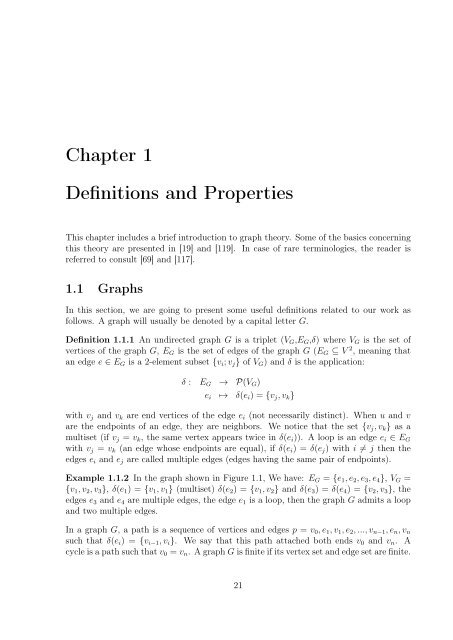enumeration of the number of spanning trees in some ... - Toubkal
enumeration of the number of spanning trees in some ... - Toubkal
enumeration of the number of spanning trees in some ... - Toubkal
Create successful ePaper yourself
Turn your PDF publications into a flip-book with our unique Google optimized e-Paper software.
Chapter 1Def<strong>in</strong>itions and PropertiesThis chapter <strong>in</strong>cludes a brief <strong>in</strong>troduction to graph <strong>the</strong>ory. Some <strong>of</strong> <strong>the</strong> basics concern<strong>in</strong>gthis <strong>the</strong>ory are presented <strong>in</strong> [19] and [119]. In case <strong>of</strong> rare term<strong>in</strong>ologies, <strong>the</strong> reader isreferred to consult [69] and [117].1.1 GraphsIn this section, we are go<strong>in</strong>g to present <strong>some</strong> useful def<strong>in</strong>itions related to our work asfollows. A graph will usually be denoted by a capital letter G.Def<strong>in</strong>ition 1.1.1 An undirected graph G is a triplet (V G ,E G ,δ) where V G is <strong>the</strong> set <strong>of</strong>vertices <strong>of</strong> <strong>the</strong> graph G, E G is <strong>the</strong> set <strong>of</strong> edges <strong>of</strong> <strong>the</strong> graph G (E G ⊆ V 2 , mean<strong>in</strong>g thatan edge e ∈ E G is a 2-element subset {v i ; v j } <strong>of</strong> V G ) and δ is <strong>the</strong> application:δ : E G → P(V G )e i ↦→ δ(e i ) = {v j , v k }with v j and v k are end vertices <strong>of</strong> <strong>the</strong> edge e i (not necessarily dist<strong>in</strong>ct). When u and vare <strong>the</strong> endpo<strong>in</strong>ts <strong>of</strong> an edge, <strong>the</strong>y are neighbors. We notice that <strong>the</strong> set {v j , v k } as amultiset (if v j = v k , <strong>the</strong> same vertex appears twice <strong>in</strong> δ(e i )). A loop is an edge e i ∈ E Gwith v j = v k (an edge whose endpo<strong>in</strong>ts are equal), if δ(e i ) = δ(e j ) with i ≠ j <strong>the</strong>n <strong>the</strong>edges e i and e j are called multiple edges (edges hav<strong>in</strong>g <strong>the</strong> same pair <strong>of</strong> endpo<strong>in</strong>ts).Example 1.1.2 In <strong>the</strong> graph shown <strong>in</strong> Figure 1.1, We have: E G = {e 1 , e 2 , e 3 , e 4 }, V G ={v 1 , v 2 , v 3 }, δ(e 1 ) = {v 1 , v 1 } (multiset) δ(e 2 ) = {v 1 , v 2 } and δ(e 3 ) = δ(e 4 ) = {v 2 , v 3 }, <strong>the</strong>edges e 3 and e 4 are multiple edges, <strong>the</strong> edge e 1 is a loop, <strong>the</strong>n <strong>the</strong> graph G admits a loopand two multiple edges.In a graph G, a path is a sequence <strong>of</strong> vertices and edges p = v 0 , e 1 , v 1 , e 2 , ..., v n−1 , e n , v nsuch that δ(e i ) = {v i−1 , v i }. We say that this path attached both ends v 0 and v n . Acycle is a path such that v 0 = v n . A graph G is f<strong>in</strong>ite if its vertex set and edge set are f<strong>in</strong>ite.21

















